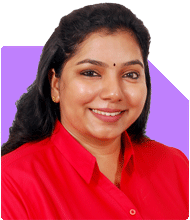Ramalingam Kalirajan |8260 Answers |Ask -Follow
Mutual Funds, Financial Planning Expert - Answered on Oct 08, 2024
He has an MBA in finance from the University of Madras and is a certified financial planner.
He is the director and chief financial planner at Holistic Investment, a Chennai-based firm that offers financial planning and wealth management advice.... more

I am currently 42 years old Insurance professional. My wife is a teacher. Together our monthly earning is 165000/-. My daughter is in class 6. Here are the details of our investment and asset. We have our own apartment hence no home loan. I want to buy another flat for my daughter. I also would like to send my daughter to Germany for masters. Currently our investment are as below : Mutual fund : We have a portfolio of 28 lakh. Our monthly investment is 35K.. Our PPF fund is 12 lakh. We invest around 1 lakh a year there. Our FD is around 22 lakh. We have endowment insurance investment of around 10 lakh.In Sukanyacsamriddhi account we have 2 lakh. Cash in bank account 8 lakh. I wish to retire at 55 with a corpus of 2 Cr with all my liabilities mitigated. How should I approach?
Assessing Your Current Investment Portfolio
Let’s review the different components of your current investment portfolio.
Mutual Funds (Rs 28 lakh): You are investing Rs 35,000 per month, which is a good contribution. Mutual funds offer long-term growth and wealth-building opportunities. However, we need to ensure that your mutual funds are diversified across different asset classes. Since you are primarily focused on retirement and your daughter’s education, having a mix of equity funds, hybrid funds, and debt funds would be ideal to balance risk and returns. Equity mutual funds can provide higher returns but come with more volatility.
Public Provident Fund (PPF, Rs 12 lakh): PPF is a safe, long-term investment option with tax benefits under Section 80C. Your yearly investment of Rs 1 lakh is prudent, as it helps build a guaranteed, risk-free retirement corpus. PPF works well for conservative investors but doesn’t generate the high returns needed for aggressive growth. You can continue with this as part of a low-risk portion of your portfolio. However, for higher growth, your focus should remain on equity mutual funds.
Fixed Deposits (Rs 22 lakh): Fixed deposits offer safety but generate low returns, which may not keep up with inflation. It’s wise to hold some portion of your assets in FDs for short-term goals or emergencies. However, a large FD balance could slow down your portfolio’s overall growth. You may want to consider reallocating some of this to mutual funds for better long-term returns. You could keep around Rs 5-10 lakh in FDs and move the rest to a well-diversified portfolio.
Endowment Insurance (Rs 10 lakh): Endowment plans mix insurance with investment, but they generally offer low returns. While they provide life cover, their investment returns tend to be much lower than mutual funds or other pure investment products. You may consider surrendering these plans and using the proceeds to invest in high-growth mutual funds. For life insurance, you can shift to a term insurance plan, which will give you higher coverage at a lower premium.
Sukanya Samriddhi Yojana (SSY, Rs 2 lakh): This is a great savings option for your daughter’s future. It provides tax benefits and has a good interest rate. Continue contributing to this as part of your child’s education fund. SSY works best for long-term savings for daughters and is a safe, government-backed scheme.
Cash in Bank (Rs 8 lakh): Keeping Rs 8 lakh in your savings account is good for emergency needs. You should maintain an emergency fund equivalent to six months of your expenses. With a combined monthly earning of Rs 1.65 lakh, an emergency fund of Rs 8 lakh is appropriate. You could consider moving any excess cash beyond your emergency fund to more productive investments like mutual funds.
Buying Another Flat for Your Daughter
You have mentioned wanting to buy another flat for your daughter. While buying real estate is often seen as a good investment, it may not always be the best option for wealth creation. Real estate investments typically offer lower returns compared to equity mutual funds in the long run. Moreover, real estate requires large upfront capital, and the returns are less liquid compared to mutual funds. Since your primary focus is retirement and your daughter’s education, prioritizing those goals through financial investments may offer better growth and flexibility.
Rather than buying another flat, consider continuing to invest in equity mutual funds. This will allow your wealth to grow faster and give you more liquidity to meet your daughter’s education expenses and retirement needs. Additionally, you can explore renting a flat when the time comes if she needs housing during her education.
Daughter’s Education in Germany
Sending your daughter to Germany for her master’s education is a commendable goal. Education abroad can be expensive, and the cost of living in Germany, tuition fees, and travel expenses should all be factored in. Based on current costs, a master’s education abroad could cost around Rs 50-70 lakh over two years. To prepare for this, you should start a dedicated investment plan for her education.
You can consider setting aside a separate portion of your monthly investments toward her education fund. Flexi-cap mutual funds or balanced hybrid funds would be suitable for this goal, as they offer a mix of growth and stability. You already have a good foundation with Rs 2 lakh in Sukanya Samriddhi Yojana. This can be complemented with additional equity investments to ensure you meet the required corpus for her education in the next 6-7 years.
Strategy to Reach Rs 2 Crore Retirement Corpus
To reach your goal of Rs 2 crore by 55, let’s focus on your existing investment strategy and how to enhance it.
Continue Investing in Mutual Funds: Your current monthly SIP of Rs 35,000 is a good amount. You should continue investing consistently. Given that you have 13 years left until retirement, the power of compounding will work in your favor. You should target equity mutual funds with a long-term growth potential. A well-diversified portfolio with exposure to large-cap, mid-cap, and small-cap funds would offer a balanced risk-return profile. It’s also essential to review and rebalance your portfolio every 1-2 years.
Increase SIP Contributions: To accelerate your wealth-building, consider increasing your monthly SIP amount by 10-15% each year. This will allow your investments to keep pace with inflation and your rising income. Gradually increasing your SIP will ensure that you are contributing more toward your retirement goal as your earnings grow.
Consider Debt Funds for Stability: Since you are nearing retirement, you could allocate a small portion of your portfolio to debt mutual funds or hybrid funds. These will provide stability and reduce the overall risk of your portfolio as you approach retirement. Debt funds offer lower volatility compared to equity funds and are suitable for those with a shorter investment horizon.
Term Insurance for Adequate Coverage: While you currently have an endowment insurance plan, term insurance would be a better option for life coverage. A term plan will offer you and your family financial security in case of any unfortunate events. The premium for term insurance is much lower than endowment plans, allowing you to free up more money for investments.
Tax Planning: Continue investing in tax-saving instruments like PPF, which offer Section 80C benefits. Additionally, your mutual fund investments can be planned to optimize your tax liability. Long-term capital gains (LTCG) above Rs 1.25 lakh from equity mutual funds are taxed at 12.5%. Planning withdrawals from your equity funds efficiently will help minimize tax payments when you begin using the corpus for retirement.
Health Insurance
It’s crucial to ensure you and your family have adequate health insurance coverage. You should review your existing health insurance policy to make sure it covers all potential medical expenses, including hospitalization, surgeries, and critical illnesses. Your wife’s coverage, if provided by her employer, can supplement your insurance, but it’s always better to have independent coverage. You may also want to consider a separate health insurance plan for your daughter, as well as additional critical illness or accident insurance.
Emergency Fund
Your emergency fund of Rs 8 lakh is adequate for now, but you should aim to increase it slightly as your expenses grow. An emergency fund equivalent to six months of your household expenses is typically sufficient. If your monthly expenses are Rs 1.65 lakh, then Rs 8-10 lakh in emergency savings is a reasonable amount. Keeping this in a liquid or short-term debt fund will help it grow slightly while still being easily accessible in case of emergencies.
Finally
You are on the right track with your investments and financial planning. Achieving your Rs 2 crore retirement goal is possible with disciplined savings, the right mix of mutual funds, and regular reviews of your portfolio.
Focus on diversifying your mutual fund portfolio to ensure a balance of risk and growth.
Consider reallocating some of your fixed deposit funds to mutual funds for better returns.
Keep your home loan for tax benefits, and use endowment plan funds for better investment opportunities.
Plan for your daughter’s education through a combination of Sukanya Samriddhi Yojana and mutual funds.
Review your health insurance to make sure you have sufficient coverage for you, your wife, and your daughter.
Gradually increase your SIP contributions to ensure you meet your retirement and education goals.
By following these steps and consistently reviewing your progress, you’ll be well-positioned to retire comfortably at 55 with the desired corpus.
Best Regards,
K. Ramalingam, MBA, CFP,
Chief Financial Planner,
www.holisticinvestment.in
https://www.youtube.com/@HolisticInvestment
You may like to see similar questions and answers below
Ramalingam Kalirajan |8260 Answers |Ask -Follow
Mutual Funds, Financial Planning Expert - Answered on Jul 08, 2024
Ramalingam Kalirajan |8260 Answers |Ask -Follow
Mutual Funds, Financial Planning Expert - Answered on Aug 28, 2024
Ramalingam Kalirajan |8260 Answers |Ask -Follow
Mutual Funds, Financial Planning Expert - Answered on Nov 07, 2024
Ramalingam Kalirajan |8260 Answers |Ask -Follow
Mutual Funds, Financial Planning Expert - Answered on Jan 29, 2025
Dr Nagarajan Jsk |323 Answers |Ask -Follow
NEET, Medical, Pharmacy Careers - Answered on Apr 18, 2025
Radheshyam Zanwar |1535 Answers |Ask -Follow
MHT-CET, IIT-JEE, NEET-UG Expert - Answered on Apr 18, 2025
Radheshyam Zanwar |1535 Answers |Ask -Follow
MHT-CET, IIT-JEE, NEET-UG Expert - Answered on Apr 18, 2025
Radheshyam Zanwar |1535 Answers |Ask -Follow
MHT-CET, IIT-JEE, NEET-UG Expert - Answered on Apr 18, 2025
Radheshyam Zanwar |1535 Answers |Ask -Follow
MHT-CET, IIT-JEE, NEET-UG Expert - Answered on Apr 18, 2025
Pushpa R |60 Answers |Ask -Follow
Yoga, Mindfulness Expert - Answered on Apr 18, 2025
Dr Nagarajan Jsk |323 Answers |Ask -Follow
NEET, Medical, Pharmacy Careers - Answered on Apr 18, 2025
Dr Nagarajan Jsk |323 Answers |Ask -Follow
NEET, Medical, Pharmacy Careers - Answered on Apr 18, 2025
Milind Vadjikar |1179 Answers |Ask -Follow
Insurance, Stocks, MF, PF Expert - Answered on Apr 18, 2025
Ravi Mittal |577 Answers |Ask -Follow
Dating, Relationships Expert - Answered on Apr 18, 2025

























